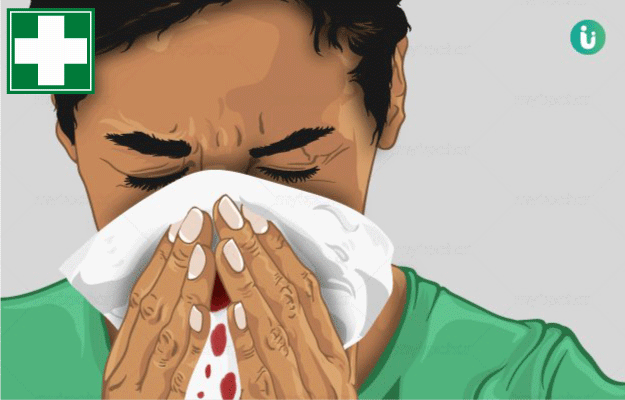Bleeding from the nose, medically known as epistaxis, is a self-limiting complaint that may occur spontaneously or due to an injury to the nose. Though it is rarely life-threatening, recurrent bleeding from the nose can be quite uncomfortable. Depending on the site of bleeding, epistaxis can be classified into two categories – anterior bleeds (bleeding occurs from the wall between the two nostrils) and posterior bleeds (begins at the back of the nose). Regardless, the condition only requires medical attention when it is recurrent or severe.
Conventionally, nosebleeds are managed through first aid, treatment of the underlying cause, medications and in some cases, surgery. Homeopathy, however, also takes into consideration the mental history of the person along with their tendency towards certain health conditions. Every patient is given a unique blend of medicine as per their body constituency and miasms. The right choice of homoeopathic remedies in the right dose for the right patient provides the most effective therapy.
Some homeopathic remedies for nosebleed include substances like aconitum napellus, arnica montana, belladonna, bryonia alba, calcarean carbonica, crocus sativus, ferrum phosphoricum, hamamelis virginiana, ipecacuanha, melilotus officinalis, millefolium, nitricum acidum, nux vomica, phosphorus and thlaspi bursa pastoris.
- Homeopathic medicines for nosebleeds
- Dietary and lifestyle changes for nosebleeds patient as per homeopathy
- How effective are homeopathic medicines and treatments for nosebleeds
- Side effects and risks of homeopathic medicine and treatments for nosebleeds
- Takeaway
Homeopathic medicines for nosebleeds
The following remedies are used for treating nosebleeds:
- Aconitum Napellus
Common Name: Monkshood
Symptoms: This remedy is given when the patient is in a state of anguish - both of the mind and body. It also helps with physical and mental restlessness that is coupled with fright. Other symptoms requiring therapy with this remedy include:- Acutely sensitive sense of smell
- Pain at the root of the nose
- Coryza (common cold) with increased sneezing
- Throbbing in nostrils
- Dry mucous membrane
- Stopped up nose with dry or scanty watery coryza
Symptoms improve when in the open air but worsen in warm rooms, during evenings and nights, with lying on the affected side, music, tobacco-smoke and dry and cold winds.
- Arnica Montana
Common Name: Leopard's bane
Symptoms: This remedy is well suited to conditions resulting from injuries, falls, blows and contusions. Indications for this remedy include:- Nosebleeds after every fit of coughing, with dark fluid blood
- Sore and cold nose
Symptoms worsen with damp and cold weather, the slightest touch, motion, rest, and consumption of wine.
- Belladonna
Common Name: Deadly nightshade
Symptoms: Belladonna acts on every part of the nervous system and is effective for symptoms like active congestion, furious excitement, twitching, convulsions and pain. Symptoms that respond to this remedy are:- Olfactory hallucination (Imagining odours)
- Tingling in the tip of the nose
- Red and swollen nose
- Bleeding of nose with a red face
- Coryza and mucus mixed with blood
Symptoms worsen with touch, noise, draught, at noon and with lying down. However, improvement is seen when in a semi-erect position.
- Bryonia Alba
Common Name: Wild hops
Symptoms: This remedy acts on all the serous membranes (a smooth layer of tissue that lines organs like heart, lungs and abdomen) and the viscera (internal organs) they contain and is used for treating muscle aches. Symptoms that respond well to this remedy are:
Symptoms worsen with warmth, any motion, in the morning, in hot weather, while eating, on exertion and with touch. Such patients find it hard to sit up and feel faint and sick easily. However, these symptoms improve by lying on the painful side, with pressure, rest and cold things.
- Calcarea Carbonica
Common Name: Carbonate of lime
Symptoms: Carbonate of lime is an excellent constitutional remedy. It affects almost every day to day activity of the body and is especially effective in dealing with nutrition impairment. This remedy is indicated in nosebleed with the following characteristics:- Dry, sore and ulcerated nostrils
- Blocked nose with a yellow discharge
- Offensive odour in the nose
- Polyps and swelling at the root of nose
- Coryza
- A tendency to catch cold every time the weather changes
- Catarrhal symptoms (excessive mucus in the airways) with hunger
- Coryza alternating with colic
Symptoms worsen from mental or physical exertion, ascending (climbing up), cold in every form, moist air, wet weather, during full moon and when standing. They improve with dry climate and weather and on lying on the painful side.
- Crocus Sativus
Common Name: Saffron
Symptoms: This remedy is often useful in haemorrhages that are black and stringy. Other indications for this remedy are:- Epistaxis that is dark, stringy and clotted
- Strings of dark blood from the nose
Symptoms worsen on lying down, in hot weather, in warm rooms, in the morning, by fasting, before breakfast and by looking fixedly at an object. Symptoms improve in open air.
- Ferrum Phosphoricum
Common Name: Phosphate of iron
Symptoms: Phosphate of iron is preferable for the first stage of all febrile (fever) conditions and inflammations before exudation (oozing) sets in. This remedy is mainly indicated for the following symptoms:- First stage of colds in the head
- Predisposition to colds
- Epistaxis with bright red blood
Symptoms worsen at night, with touch, motion and by lying on the right side. Symptoms improve with cold applications.
- Hamamelis Virginica
Common Name: Witch-hazel
Symptoms: Witch hazel relaxes the walls of veins, leading to engorgement. Symptoms treated with this remedy are:- Profuse, passive, non-coagulable bleeding from nose, with tightness in the bridge of the nose
- Bad odour from nose
Symptoms worsen with warm and moist air
- Ipecacuanha
Common Name: Ipecac-root
Symptoms: Symptoms responding well to this remedy are:- Coryza
- Blocked nose and nausea
Symptoms worsen periodically from moist warm wind and lying down
- Melilotus Officinalis
Common Name: Yellow melilot, sweet clover (melilotus)
Symptoms: Symptoms indicating treatment with this remedy include:- Stopped up, dry nose
- Dry, hard clinkers in the nose
- Profuse epistaxis
Symptoms worsen in rainy and changing weather, with the approach of storm or with motion
- Millefolium
Common Name: Yarrow
Symptoms: Millefolium is an invaluable remedy for various types of haemorrhages with bright red blood.
Apart from nosebleeds, this remedy provides relief from piercing pain that radiates from the eyes to root of nose.
- Nitricum Acidum
Common Name: Nitric acid
Symptoms: This remedy acts best in dark-complexioned patients who are past middle age. It is selected for its action on the sites where the mucous membranes and skin meet. Symptoms that indicate a need for this remedy are:- Green casts from nose every morning
- Coryza, with sore and bleeding nostrils
- Redness at the tip of the nose
- Nosebleed, with chest infections
- Chronic nasal catarrh with yellowish, corrosive discharge
- Nasal diphtheria, with watery and excoriating discharge
These symptoms worsen in the evening, at night, with cold climate and hot weather.
- Nux Vomica
Common Name: Poisonnut
Symptoms: Nux vomica is the preferred choice of therapy for many conditions. Symptoms that can be treated with this remedy are:- Stuffy nose, especially at night
- Stuffy colds and snuffles after exposure to dry or cold atmosphere
- Colds that get worse in a warm room
- Fainting due to strong odours
- Coryza, which is fluent in the daytime, stuffy nose at night and on going outdoors that alternates between nostrils
- Nosebleeds in the morning
- Acrid nasal discharge but with a stuffed up feeling
Symptoms worsen in the morning, with mental exertion, after eating, with touch, consumption of spices, stimulants, narcotics, dry weather and cold. Improvement is seen by taking regular naps, in the evenings, while at rest, in damp and wet weather or with strong pressure.
- Phosphorus
Common Name: Phosphorus
Symptoms: Phosphorus is otherwise a toxic element; however, in homeopathy, it is prepared as a medicine in such a way so as to eliminate the harmful effects. Symptoms requiring this remedy are:- Fan-like motion of nostrils
- Epistaxis instead of periods
- Over-sensitive sense of smell
- Periostitis of nasal bones (inflammation of tissue that surrounds the bone)
- Olfactory hallucinations (Noticing foul imaginary odours)
- Small haemorrhages; handkerchief is always bloody
- Polyps that bleed easily
Symptoms worsen on touch, with physical or mental exertion, in twilight, with warm food or drink, change of weather, from getting wet in hot weather, in the evening, by lying on the left or painful side, during a thunderstorm and on ascending stairs. Improvement is observed in the dark, by lying on the right side, with cold food, cold air, washing with cold water and adequate sleep.
- Thlaspi Bursa Pastoris
Common Name: Shepherd's purse
Symptoms: Shepherd's purse is an anti-haemorrhagic and anti-uric-acid remedy. This remedy is used for:- Bleeding associated with nasal operations
- Passive haemorrhage (bleeding from veins instead of arteries)
Dietary and lifestyle changes for nosebleeds patient as per homeopathy
Do’s:
- Keep the room cool and well ventilated.
- Weather conditions that one is exposed to should be favourable for the optimal action of the prescribed remedy.
- Follow a healthy diet and lifestyle. (Read more: Balanced diet components)
- Keep your surroundings clean and tidy.
- To minimise the risk of nosebleeds, walk slowly and perform light exercises as tolerated.
Don’ts:
- Avoid caffeinated drinks, fine Chinese tea and other herbal teas.
- Avoid beer and liquor made with medicinal substances.
- Avoid strong-smelling products like odorous water and perfumes of different types.
- Avoid spicy foods and sauces, old cheese, spiced cakes, spiced chocolates, dishes made from herbs, roots and stalks of plants possessing medicinal qualities, celery and onions.
- Avoid spoilt/stale meats or meats that possess medicinal properties (e.g. flesh and fat of ducks and geese and sour foods).
- Do not take an excess of sugar, salt and spirituous drinks.
- Avoid rough exercise and motion that may cause the nose to bleed again.
How effective are homeopathic medicines and treatments for nosebleeds
Depending on the symptoms observed, homeopathic physicians prescribe specific remedies for an individual's symptoms. Homeopathic treatment aims at addressing the underlying cause and individual susceptibility rather than just treating the related symptoms. Nosebleeds occurring due to factors such as coughing and eating are treated using remedies like arnica montana, whereas nosebleeds due to haemophilia are treated using remedies like ipecacuanha and phosphorus.
Side effects and risks of homeopathic medicine and treatments for nosebleeds
Homeopathy is a healing art based on the law : ‘like cures like’. This means a substance that produces certain symptoms in a healthy individual can be used to treat the same symptoms in a sick person, provided that it is diluted and prepared in a specific way. Since homeopathic remedies are highly diluted they have minimal side effects. Rarely, on receiving a homeopathic remedy, you may experience a worsening of effects before you see improvements, which is nothing but a typical dip in the healing process.
Takeaway
Homoeopathy is efficient in the treatment of epistaxis or nosebleeds. In general, homoeopathic physicians prescribe the remedies in centesimal potencies. Homoeopathy follows a curative approach using remedies that not only treat the symptoms but also address the cause of the epistaxis with the highest standards of safety and efficacy.
Find Homeopathic Doctor in cities
References
- Oscar E. Boericke. Nose. Médi-T; [lnternet]
- William Boericke. Homoeopathic Materia Medica. Kessinger Publishing: Médi-T 1999, Volume 1
- Wenda Brewster O’Reilly. Organon of the Medical art by Wenda Brewster O’Reilly . B jain; New Delhi
- Tabassom A, Cho JJ. Epistaxis (Nose Bleed). In: StatPearls [Internet]. Treasure Island (FL): StatPearls Publishing; 2019 Jan
- MedlinePlus Medical Encyclopedia: US National Library of Medicine; Nosebleed
- Ministry of AYUSH, Govt. of India. Ministry of AYUSH. [Internet]













